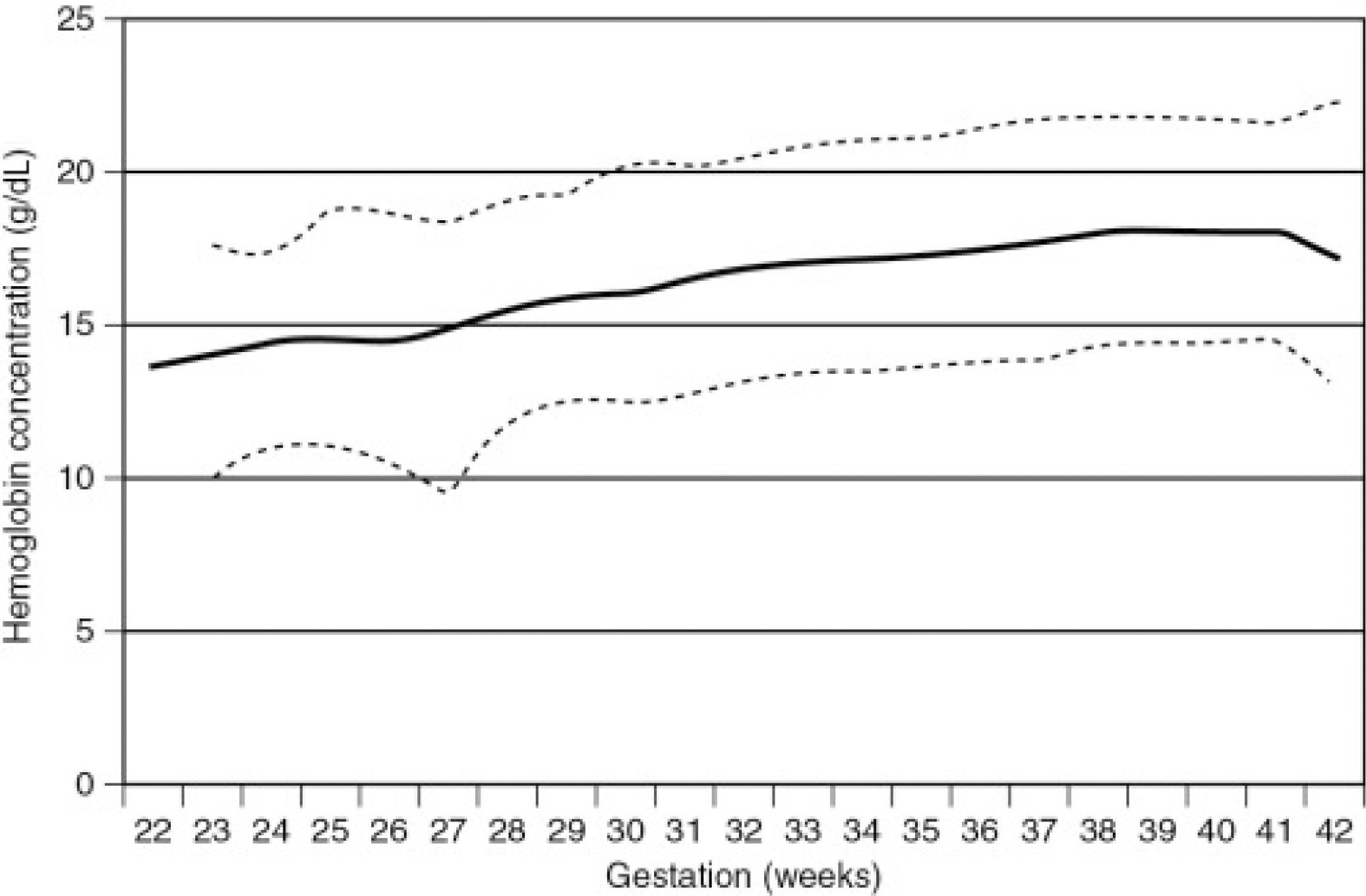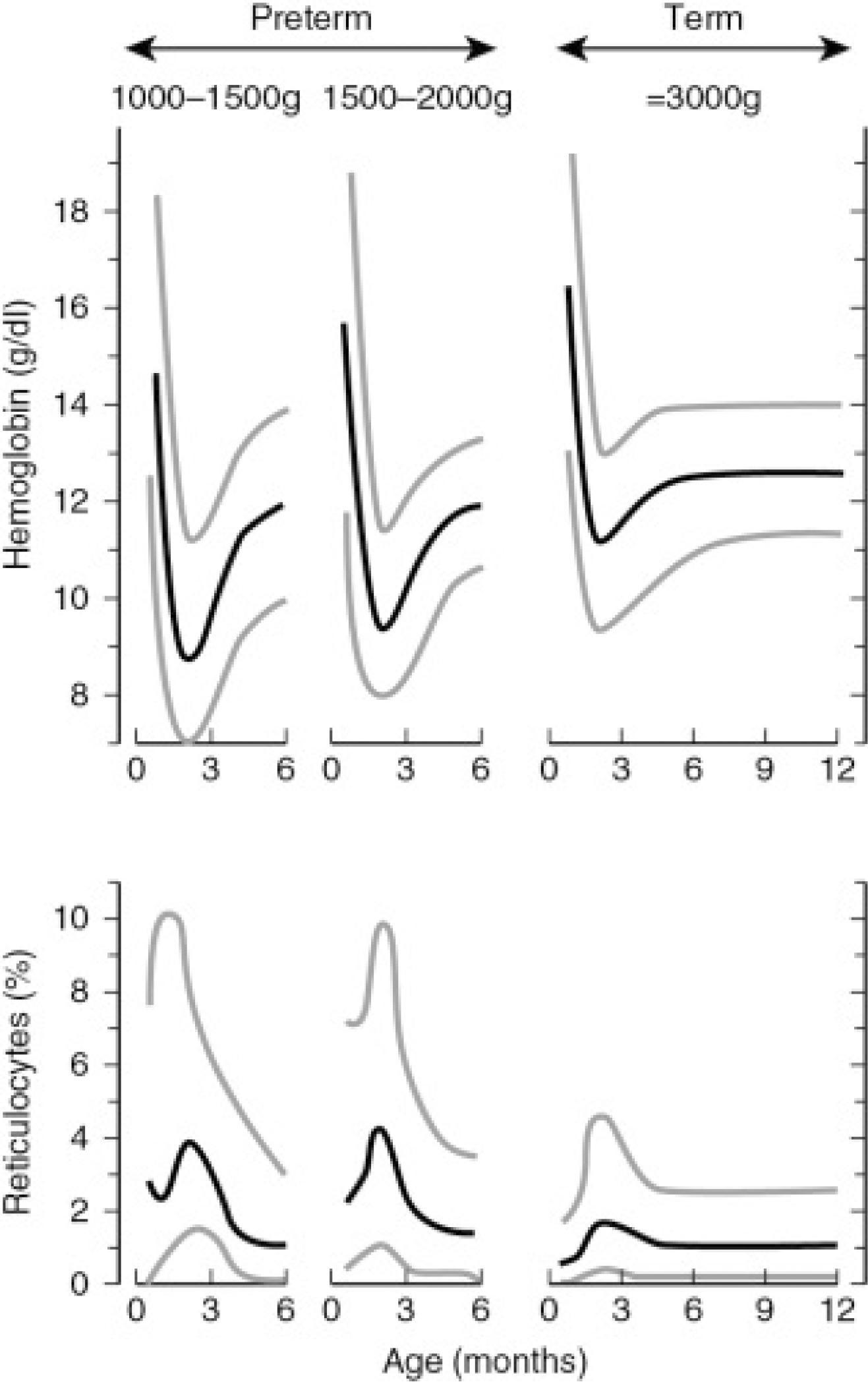Physical Address
304 North Cardinal St.
Dorchester Center, MA 02124
Anemia occurs when the red blood cell (RBC) mass is not adequate to meet tissue oxygen needs.
Target hemoglobin and hematocrit have been used as clinical indicators for RBC transfusion in preterm infants with acute and chronic anemia.
The minimal target hematocrit or hemoglobin that optimally balances the risks and benefits of transfusion remains unknown because a marker for transfusion need has not been identified.
The two largest multicenter trials evaluating liberal versus restrictive transfusion guidelines in extremely low birth weight infants were conclusive in confirming a restrictive approach to red cell transfusions.
In extremely low birth weight infants, a restrictive approach to transfusions should be instituted, because it results in fewer transfusions and does not increase the risk of morbidity, death, or neurodevelopmental impairment.
Fetal hematocrit and hemoglobin concentrations gradually increase as gestation increases. Fetal erythropoiesis is stimulated by fetal erythropoietin (Epo), produced in response to the fetal hypoxic environment ( Fig. 44.1 ), where P o 2 values range from 20 to 35 torr ( Fig. 44.2 ). Oxygen extraction from the placental circulation is augmented by the high percentage of fetal hemoglobin, which has a greater oxygen affinity than adult hemoglobin ( Fig. 44.2 ). P o 2 values increase once an infant is born, resulting in a rapid decline in Epo production and cessation of erythropoiesis.


Anemia occurs when the volume of circulating red cells fails to meet the metabolic needs of tissues. Preterm infants born <1500 g (very low birth weight [VLBW]) are frequently transfused due to common clinical characteristics and features of prematurity that, compounded, result in a significant fall in hemoglobin and hematocrit in the first weeks of life. These characteristics include (1) lower hemoglobin concentrations at lower gestational ages ( Fig. 44.3 ); (2) ongoing loss of red cells due to phlebotomy, sometimes equaling an entire blood volume (80–85 mL/kg) in the first weeks of life; (3) a shortened red cell life span of 60 to 70 days; and (4) lack adequate endogenous Epo production after birth to maintain the red cell mass. All of these characteristics lead to a fall in hemoglobin and hematocrit that is greater than that seem normally in term infants during their physiologic nadir ( Fig. 44.4 ), resulting in frequent transfusions.


Indications for neonatal transfusions differ based on the rate of fall in hemoglobin. In an infant with acute blood loss, the need for a transfusion is generally dependent on persistent clinical signs of inadequate oxygen delivery following the restoration of intravascular volume. Infants with chronic anemia may also exhibit clinical signs of inadequate oxygen delivery such as increased resting heart rate, acidosis, poor growth, and apnea, and a need for increased respiratory support, that are often ameliorated by a transfusion.
Red cell transfusions are currently the accepted treatment for acute anemia, especially anemia due to hemorrhage, because they rapidly increase available oxygen. The oxygen content is based on the following equation:
In this equation, 1.34 equals the mL of oxygen binding to each gram of hemoglobin, and 0.003 equals the mL of oxygen dissolved in blood per mm Hg. Oxygen availability and delivery to tissues is proportional to oxygen content and cardiac output. When cardiac output is adequate and optimized, red cell transfusions rapidly increase oxygen availability to tissues. There are, however, a growing list of risks associated with transfusions, including transmission of infection, graft-versus-host disease, transfusion-related acute lung injury, transfusion associated circulatory overload, and toxic contamination of blood products with heavy metals. In the preterm infant population, red cell transfusions may be associated with an increased risk of necrotizing enterocolitis (NEC), extension of intraventricular hemorrhage (IVH), increased mortality, or impaired developmental outcome. , A causal relationship with any of these adverse events is still being determined. Neonatal transfusions can result in increases in proinflammatory cytokines such as ICAM-1, IL-1β, IL-8, IL-10, IFN-γ, IL-17, and MCP-1, potentially increasing or worsening morbidities associated with prematurity. These potential complications underscore the need to carefully evaluate the need for a rapid increase in oxygen availability to tissues prior to ordering a nonemergent transfusion in a preterm infant. Similar to the growing emphasis on antibiotic stewardship, where antibiotics are being reassessed and more stringently prescribed, “transfusion stewardship” will hopefully provide greater focus for providers to practice evidence-based ordering of blood products for neonates.
It can be a challenge determining which neonate with a low hematocrit will benefit from a red cell transfusion. Many preterm infants can adapt to a slowly decreasing hematocrit and can be treated conservatively with supplemental iron and red cell growth factors such as Epo or darbepoetin (Darbe) to avoid the associated risks of transfusion. , Target hemoglobin and hematocrit have been used as clinical indicators for red blood cell (RBC) transfusion; however, it remains uncertain what target hematocrit or hemoglobin will optimally balance the risks and benefits of this intervention. This chapter focuses on exploring the development of evidence-based transfusion guidelines in the newborn intensive care unit (NICU).
Become a Clinical Tree membership for Full access and enjoy Unlimited articles
If you are a member. Log in here